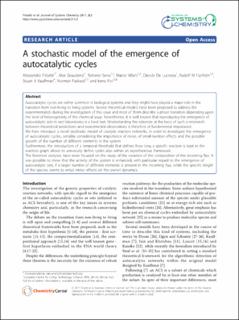Please use this identifier to cite or link to this item:
https://doi.org/10.21256/zhaw-1673| Publication type: | Article in scientific journal |
| Type of review: | Peer review (publication) |
| Title: | A stochastic model of the emergence of autocatalytic cycles |
| Authors: | Filisetti, Alessandro Graudenzi, Alex Serra, Roberto Villani, Marco DeLucrezia, Davide Füchslin, Rudolf Marcel Kauffman, Stuart A. Packard, Norman Poli, Irene |
| DOI: | 10.21256/zhaw-1673 10.1186/1759-2208-2-2 |
| Published in: | Journal of Systems Chemistry |
| Volume(Issue): | 2 |
| Issue: | 2 |
| Issue Date: | 2011 |
| Publisher / Ed. Institution: | BioMed Central |
| ISSN: | 1759-2208 |
| Language: | English |
| Subjects: | Temporal window; Average connectivity; Gillespie algorithm; Reaction graph; Transient complex |
| Subject (DDC): | 540: Chemistry 570: Biology |
| Abstract: | Autocatalytic cycles are rather common in biological systems and they might have played a major role in the transition from non-living to living systems. Several theoretical models have been proposed to address the experimentalists during the investigation of this issue and most of them describe a phase transition depending upon the level of heterogeneity of the chemical soup. Nevertheless, it is well known that reproducing the emergence of autocatalytic sets in wet laboratories is a hard task. Understanding the rationale at the basis of such a mismatch between theoretical predictions and experimental observations is therefore of fundamental importance. We here introduce a novel stochastic model of catalytic reaction networks, in order to investigate the emergence of autocatalytic cycles, sensibly considering the importance of noise, of small-number effects and the possible growth of the number of different elements in the system. Furthermore, the introduction of a temporal threshold that defines how long a specific reaction is kept in the reaction graph allows to univocally define cycles also within an asynchronous framework. The foremost analyses have been focused on the study of the variation of the composition of the incoming flux. It was possible to show that the activity of the system is enhanced, with particular regard to the emergence of autocatalytic sets, if a larger number of different elements is present in the incoming flux, while the specific length of the species seems to entail minor effects on the overall dynamics. |
| URI: | https://digitalcollection.zhaw.ch/handle/11475/2784 |
| Fulltext version: | Published version |
| License (according to publishing contract): | CC BY 2.0: Attribution 2.0 Generic |
| Departement: | School of Engineering |
| Appears in collections: | Publikationen School of Engineering |
Files in This Item:
| File | Description | Size | Format | |
|---|---|---|---|---|
| 2011_Filisetti_A stochastic model_Journal of Systems Chemistry.pdf | 723.15 kB | Adobe PDF |  View/Open |
Show full item record
Filisetti, A., Graudenzi, A., Serra, R., Villani, M., DeLucrezia, D., Füchslin, R. M., Kauffman, S. A., Packard, N., & Poli, I. (2011). A stochastic model of the emergence of autocatalytic cycles. Journal of Systems Chemistry, 2(2). https://doi.org/10.21256/zhaw-1673
Filisetti, A. et al. (2011) ‘A stochastic model of the emergence of autocatalytic cycles’, Journal of Systems Chemistry, 2(2). Available at: https://doi.org/10.21256/zhaw-1673.
A. Filisetti et al., “A stochastic model of the emergence of autocatalytic cycles,” Journal of Systems Chemistry, vol. 2, no. 2, 2011, doi: 10.21256/zhaw-1673.
FILISETTI, Alessandro, Alex GRAUDENZI, Roberto SERRA, Marco VILLANI, Davide DELUCREZIA, Rudolf Marcel FÜCHSLIN, Stuart A. KAUFFMAN, Norman PACKARD und Irene POLI, 2011. A stochastic model of the emergence of autocatalytic cycles. Journal of Systems Chemistry. 2011. Bd. 2, Nr. 2. DOI 10.21256/zhaw-1673
Filisetti, Alessandro, Alex Graudenzi, Roberto Serra, Marco Villani, Davide DeLucrezia, Rudolf Marcel Füchslin, Stuart A. Kauffman, Norman Packard, and Irene Poli. 2011. “A Stochastic Model of the Emergence of Autocatalytic Cycles.” Journal of Systems Chemistry 2 (2). https://doi.org/10.21256/zhaw-1673.
Filisetti, Alessandro, et al. “A Stochastic Model of the Emergence of Autocatalytic Cycles.” Journal of Systems Chemistry, vol. 2, no. 2, 2011, https://doi.org/10.21256/zhaw-1673.
Items in DSpace are protected by copyright, with all rights reserved, unless otherwise indicated.